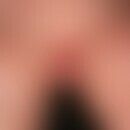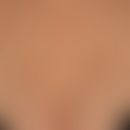Synonym(s)
HistoryThis section has been translated automatically.
DefinitionThis section has been translated automatically.
Rare, self-limiting, relapsing, very itchy, pustular dermatitis (blood eosinophilia; no further systemic involvement) with intraepidermal eosinophilic pustules occurring in adults, newborns and children.
You might also be interested in
ClassificationThis section has been translated automatically.
- Classic Eosinophilic Pustular Folliculitis (Ofuji Folliculitis)
- Immunodeficiency-associated eosinophilic pustular folliculitis
- Infantile eosinophilic pustular folliculitis
Occurrence/EpidemiologyThis section has been translated automatically.
Rarely. Mainly appearing in Japan, in the last few years occasionally also in Europe.
EtiopathogenesisThis section has been translated automatically.
Unknown.
In theinfantile form , previous infections(scabies, larva migrans) and bacterial infections (Pseudomonas) have been described.
In the adult form, patients with immunodeficiency (stem cell transplants or hematologic systemic diseases (T- and B-cell lymphomas) have been described.
Approximately 10-20% of cases are associated with HIV infection (Kanaki T et al. 2021).
Eosinophilia-inducing drugs can also trigger the clinical picture. Triggering by carbamazepine and allopurinol has been described (Mizoguchi S et al. 1998).
ManifestationThis section has been translated automatically.
Infantile form: Sporadic occurrence in children. It mainly affects infants (the prevalences are given differently: w>m; same distribution) aged 5-10 months. Rarely occurring in newborns. Occasional neonatal cases also exist.
Adult form: The disease mainly affects young men (3rd-4th decade of life). As in the infantile form, men are affected 4-5 times more frequently than women.
LocalizationThis section has been translated automatically.
Infantile form: Capillitium, face, here mainly forehead area.
Adult form: trunk and extremities.
Clinical featuresThis section has been translated automatically.
Adult form: often associated with immunodeficiencies. Disseminated, very itchy and reddened papules and plaques with development of sterile (follicular) pustules. Confluence to larger foci is possible; also anular and polycyclic foci with central regression and peripheral progression may occur. Clinical pictures as in erythema exsudativum multiforme are possible, especially in adults. Healing often occurs with hyperpigmentation. At the capillitium a circumscribed atrophying alopecia of the pseudopélade type is possible.
In the infantile form, highly itchy follicular vesicles and pustules of 0.2-0.3 cm in diameter are observed. Lesions are not anular or serpiginous. No association with HIV or other immunodeficiencies. The children are extremely irritable during a relapse activity.
LaboratoryThis section has been translated automatically.
HistologyThis section has been translated automatically.
Intraepidermal, also subcorneal pustules with abundant eosinophilic leukocytes in the pustules. Inflammatory, eosinophilic infiltrate also perifollicular and around sweat glands. Spongiosis of the outer hair root sheath with dense eosinophilic infiltrate.
Pattern: Superficial interstitial eosinophilic spongiotic dermatitis with folliculitis
DiagnosisThis section has been translated automatically.
Differential diagnosisThis section has been translated automatically.
In the differential diagnosis there are clear differences between the adult and infantile forms of the disease.
- Infantile form:
- Erythema neonatorum: little pruritus, omission of palmae and plantae, no eosinophilia.
- Melanosis, transient neonatal pustular: Already manifest at birth. Preferentially occurring in colored individuals. Involvement of palmae and plantae is typical, as are postinflammatory brown spots.
- Incontinentia pigmenti, type Bloch-Sulzberger: mainly occurring in girls; appearing in utero or directly after birth. Efflorescences in stripe- or girlade-shaped partly also whorled arrangement (Blaschko lines). After healing of the acute manifestations, typical pigmentation disorders in a spatter-like or stripe-like arrangement. Accompanying symptoms include nail dystrophy, dental hypoplasia, hypodontia, and others; high blood and tissue eosinophilia are present in the laboratory.
- Infantile scabies: face, head, neck and often palmae and plantae are affected. Efflorescences in children are often very succulent. There is persistent excruciating pruritus. Vesicles and pustules may occur. These may be clinically prominent.
- Acute Langerhans cell histiocytosis ( Abt-Letterer-Siwe type disease): rare; severe consumptive systemic disease; disseminated small, flat, yellow-brownish, scaly or crusty papules, erosions, and ulcers. Seborrheic areas are particularly affected. Pustules are rare.
- Impetigo neonatorum: Frequently starting on the face; glass pinhead-sized vesicles; pustules; pruritus; prompt response to antibiotics.
- Miliaria pustulosa: dense pinhead- to small lens-sized pustules; increased in intertrigines.
- Adult form:
- Dermatitis herpetiformis
- pustular psoriasis
- nummular eczema with impetiginization
- Candidiasis
- Pustulosis palmaris et plantaris
- tinea capitis
- scabies.
TherapyThis section has been translated automatically.
Topical (and/or systemic) glucocorticoids and/or UV-B therapy over a period of several weeks are considered the treatment of choice.
Supplementary for pruritus: 1st and 2nd generation antihistamines.
Among the topical drugs also calcineurin inhibitors, e.g. tacrolimus, are applied.
In eosinophilic folliculitis of the immunosuppressed the most important treatment is cART (combined antiretroviral therapy).
External therapyThis section has been translated automatically.
Drying measures with lotio alba and addition of 3-5% clioquinol R050, zinc oxide shaking mixture R292, if necessary topical glucocorticoids such as betamethasone valerate or hydrocortisone in lotio or cream (e.g. Betnesol-V, hydrogals, R120 R030 R029 R259 ).
Radiation therapyThis section has been translated automatically.
Internal therapyThis section has been translated automatically.
Indomethacin initial 75 mg/day, later reduction to maintenance dose depending on the clinic. The recurrence rate after discontinuation of indomethacin is 80%, therefore long-term maintenance therapy with 50 mg/day.
Experimental use of sulphones such as DADPS (e.g. Dapson Fatol) 100-150 mg/day. Alternatively long-term glucocorticoid medication with the lowest possible maintenance dose (below the Cushing's threshold) or initial combination therapy DADPS with steroid.
Symptomatic therapy of itching with H1 antagonists, e.g. desloratadine (Aerius) 1 tbl/day p.o. or levocetirizine (Xusal) 1 tbl/day p.o.
In addition, therapies with ciclosporin, permethrin or metronidazole have been described in individual cases.
Progression/forecastThis section has been translated automatically.
Note(s)This section has been translated automatically.
LiteratureThis section has been translated automatically.
- Breit R et al (1991) Classic form of eosinophilic pustular folliculitis - successful therapy with PUVA. Dermatologist 42: 247-250
- Ellis E et al (2004) Eosinophilic pustular folliculitis: a comprehensive review of treatment options. Am J Clin Dermatol 5: 189-197.
- Gul U et al (2007) Eosinophilic pustular folliculitis: the first case associated with hepatitis C virus. J Dermatol 34: 397-399
- Ise S, Ofuji S (1965) Subcorneal pustular dermatosis. A follicular variant?. Arch Dermatol 92: 169-171
- Kanaki T et al (2021) Eosinophilic pustular folliculitis (EPF) in a patient with HIV infection. Infection. 49:799-801.
- Katoh M et al. (2013) Eosinophilic pustular folliculitis: a review of the Japanese published works. J Dermatol 40:15-20.
- Kim BW et al (2014) Eosinophilic pustular folliculitis: association with long-term immunosuppressant use in a solid organ transplant recipient. Ann Dermatol 26:520-521
- Mizoguchi S et al (1998) Eosinophilic pustular folliculitis induced by carbamazepine. J Am Acad Dermatol 38:641-643.
- Ofuji S et al (1970) Eosinophilic pustular folliculitis. Acta Derm Venereol 50: 195-203.
- Ono K et al. (2014) Eosinophilic pustular folliculitis Clinically Presenting as Orofacial Granuloma: Successful Treatment with Indomethacin, but not Ibuprofen. Acta Derm Venereol doi: 10.2340/00015555-1926
- Yoneda K et al (2007) Eosinophilic pustular folliculitis associated with pulmonary eosinophilia. J Eur Acad Dermatol Venereol 21: 1122-1124.
- Yamamoto Y et al (2014) Clinical Epidemiology of Eosinophilic Pustular Folliculitis: Results from a Nationwide Survey in Japan. Dermatology 230: 87-92.
- Zitelli K et al. (2014) Eosinophilic folliculitis occurring after stem cell transplant for acute lymphoblastic leukemia: a case report and review. Int J Dermatol doi: 10.1111/ijd.12521.
Incoming links (21)
Betamethasone valerate cream hydrophilic 0.025/0.05 or 0.1% (nrf 11.37.); Betamethasone valerate emulsion hydrophilic 0,025/0,05 or 0,1 % (nrf 11.47.); Candida folliculitis; Clioquinol lotio 0.5-5%; Dermatitis cruris pustulosa et atrophicans; Eosinophilia and skin; Eosinophilic pustular folliculitis; Eosinophilic pustulous folliculitis of childhood; Eosinophil pustular folliculitis; Eosinophil pustulose; ... Show allOutgoing links (43)
Abt-letterer-siwe disease; Allopurinol; Antihistamines; Betamethasone valerate; Betamethasone valerate cream hydrophilic 0.025/0.05 or 0.1% (nrf 11.37.); Betamethasone valerate emulsion hydrophilic 0,025/0,05 or 0,1 % (nrf 11.47.); Calcineurin inhibitors; Candidoses; Carbamazepine; Cart; ... Show allDisclaimer
Please ask your physician for a reliable diagnosis. This website is only meant as a reference.








